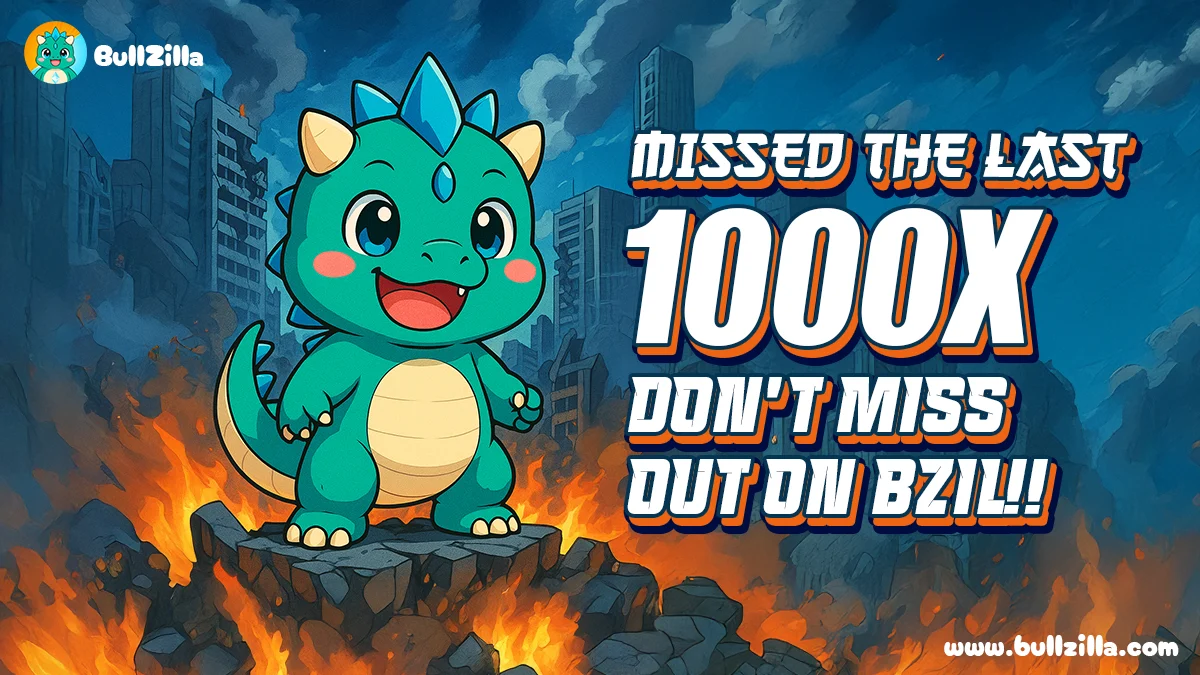Ripple Surges and MEW Sparks Interest as BullZilla at $0.00002575 Becomes One of the Top Cryptos to Buy Now

In the fast-moving crypto market, investors are always hunting for the next wave of promising projects. Recently, Ripple’s price surged sharply, and Cat in a Dog’s World has sparked fresh curiosity despite some setbacks. But standing out amid these is BullZilla ($BZIL), a project currently in presale with a price of just $0.00002575, showing tremendous promise for explosive growth. This article takes a detailed look at these three cryptocurrencies to understand their unique strengths and why they are among the top cryptos to buy now.
BullZilla: The Undisputed Presale Powerhouse Poised for Massive Growth
BullZilla is making waves with its innovative approach and strong presale performance. Currently in its first stage of the Project Trinity Boom and the fourth phase overall, BullZilla is priced at $0.00002575 in the presale. With over $147,000 raised and more than 522 token holders, the project has already delivered an impressive return on investment, with some early backers seeing gains exceeding 20,000%.

One of the key drivers of BullZilla’s success is its Roar Burn Mechanism. This system actively reduces the total token supply at predefined milestones by burning tokens from the Burn Pool Reserve. This deliberate reduction in supply increases scarcity, making the remaining tokens more valuable. Each burn event triggers a “Roar Surge,” creating social excitement and signaling growth to the community. This dynamic mechanism helps build momentum while naturally driving price appreciation.
In addition to scarcity, BullZilla’s ecosystem features the Roarblood Vault, a treasury designed to support ongoing community growth and reward loyal holders. The Vault powers a referral program where users receive bonuses for bringing new investors into the fold. This not only incentivizes participation but also strengthens the network effect crucial for long-term success.
Investing $7,000 in BullZilla: A Potential Game-Changer
| Investment Amount | Presale Price | Tokens Acquired | Projected Listing Price | Potential Value at Listing Price |
| $7,000 | $0.00002575 | 271,600,000 $BZIL | $0.0052 | Over $1,400,000 |
BullZilla’s presale model doesn’t just offer low entry prices; it combines engineered scarcity through token burns and incentivized community building through referrals. Together, these features create a feedback loop that could accelerate growth and provide significant upside for investors.
Ripple: A Resilient Force Gaining Momentum
Ripple has demonstrated a significant price increase recently, reflecting renewed confidence from the market. With its price climbing steadily, Ripple continues to carve a niche as a blockchain solution optimized for fast and affordable international payments. Its underlying technology focuses on efficiency, settling transactions in seconds rather than minutes. This gives Ripple a practical edge in an industry often hampered by slow and expensive transfers.
This surge is not just a market movement; it reflects growing adoption by financial institutions that rely on Ripple’s technology for cross-border money transfers. These partnerships create a consistent demand for Ripple tokens, bolstering its value. While market fluctuations are inevitable, Ripple’s robust utility and real-world use cases offer investors a stable foundation.
For those seeking cryptocurrencies with tangible applications and proven scalability, Ripple represents a smart choice in a volatile market.
Cat in a Dog’s World: A Meme Coin That Keeps the Community Buzzing
Unlike Ripple’s steady upward movement, Cat in a Dog’s World has experienced a modest decline recently. Its current price drop has not diminished the enthusiasm surrounding it. This meme coin taps into a unique cultural niche that blends humor with blockchain technology, creating an engaged community of supporters and traders.
What keeps Cat in a Dog’s World interesting is its focus beyond mere speculation. It has built an ecosystem where holders can interact with NFTs and participate in creative projects, which helps sustain engagement and adds a layer of utility. This approach sets it apart from other meme coins that rely solely on hype.
Though it remains a higher-risk asset, CIDW appeals to investors attracted to community-driven projects that combine fun with potential for value appreciation. As meme coins continue to evolve, those with active ecosystems stand a better chance at long-term relevance.

Conclusion: Why These Cryptos Matter in Today’s Market
Ripple’s recent price surge underscores the value of blockchain solutions with real-world applications and institutional support. Meanwhile, Cat in a Dog’s World showcases how meme coins can still capture attention by building engaged and creative communities, despite market dips. However, Bull Zilla stands apart as a rare gem, blending advanced tokenomics, community incentives, and a compelling presale opportunity.
For anyone looking for top cryptos to buy now, BullZilla’s Roar Burn Mechanism and Roarblood Vault create a strong foundation for both short-term gains and long-term value. With its current presale price and potential for exponential returns, BullZilla offers a well-rounded package of growth, scarcity, and community strength.
As the crypto market continues to evolve, projects that combine innovation with real incentives for holders are more likely to succeed. BullZilla embodies this trend and deserves attention from investors seeking the next breakthrough in cryptocurrency.

For More Information:
BZIL Official Website
Join BZIL Telegram Channel
Follow BZIL on X (Formerly Twitter)
Frequently Asked Questions about Top Cryptos to Buy Now
What is unique about BullZilla’s token burn system?
It reduces the token supply live on the blockchain at key project milestones, increasing scarcity and driving value.
Why is Ripple’s price rising recently?
Due to its utility in fast cross-border payments and growing partnerships, Ripple is gaining renewed investor confidence.
How does Cat in a Dog’s World maintain interest?
Through its community focus and interactive NFT ecosystem, keeping users engaged beyond price speculation.
What stage is BullZilla currently in?
BullZilla is in Stage 1 of Project Trinity Boom, Phase 4, during its ongoing presale.
How much ROI have early BullZilla investors seen?
Early investors have enjoyed over 20,000% ROI from Stage 1D to the projected listing price.
What rewards does BullZilla offer for referrals?
Referral users get a 10% bonus on purchases over $50, and referrers earn 10% of all referred buys.
Is investing in BullZilla risky?
All crypto investments carry risks, including volatility and regulatory changes; due diligence is essential.
Glossary
- Presale: Early opportunity to buy tokens before public market listing.
- Token Burn: Permanent destruction of tokens to reduce supply.
- ROI (Return on Investment): Profit percentage relative to initial investment.
- Blockchain: A secure, distributed ledger technology for transactions.
- Deflationary Tokenomics: Economic design to reduce token supply over time.
- Referral System: Program rewarding users for bringing new participants.
- Meme Coin: A cryptocurrency often built around community and humor.
- Listing Price: Initial price when a token becomes publicly available.
- Ecosystem: The network of users, features, and applications supporting a project.
- Tokenomics: The economic model governing a cryptocurrency.
Disclaimer
This article explores the current market momentum of Ripple, the community-driven appeal of Cat in a Dog’s World, and the innovative tokenomics of BullZilla, a cryptocurrency in presale. Ripple’s recent price gains stem from its real-world payment applications, while Cat in a Dog’s World maintains engagement through unique NFT ecosystems despite price dips. BullZilla stands out due to its Roar Burn Mechanism, which decreases supply and drives value, and the Roarblood Vault that rewards community loyalty through referrals. With over 20,000% ROI potential and a strong presale, BullZilla emerges as one of the top cryptos to buy now for investors seeking growth and sustainability in 2025.
This article is not intended as financial advice. Educational purposes only.
You May Also Like

Bitcoin White Paper: A Peer-to-Peer Cash System

ASTER is on the Crypto Market’s Spotlight: Huge Whales Are Very Active
